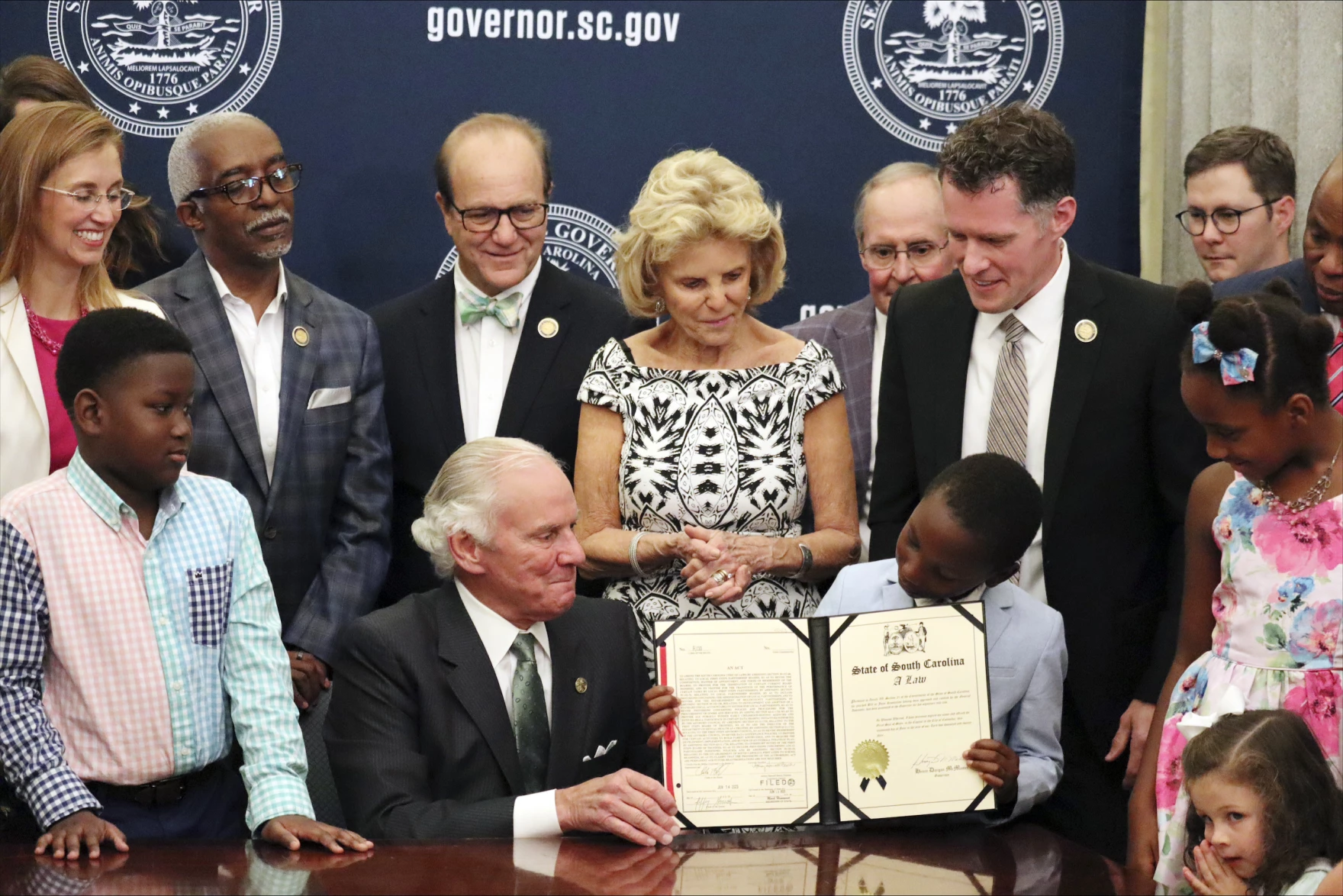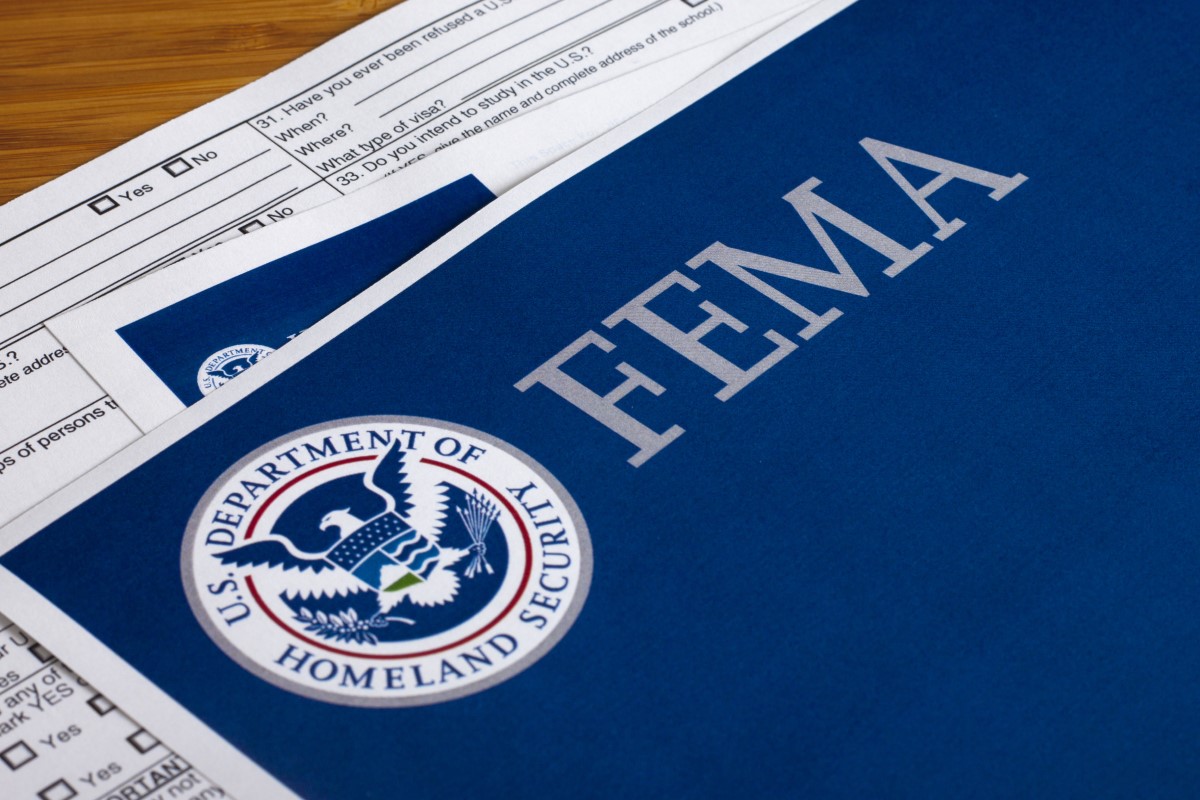States have proven they can build the necessary infrastructure and operations that fully appreciate the business model of the early childhood sector with consistent investments in resources, necessary flexibilities, and integrated systems.
(Download)
The COVID-19 pandemic placed an unprecedented strain on the early childhood sector, compounding serious pre-pandemic problems that threatened to wreak havoc on what is arguably the backbone of the U.S. economy, working parents. Multiple studies showed that many providers shuttered at the pandemic’s start. One report found that close to 16,000 licensed providers nationwide permanently closed between December 2019 and March 2021. Further, employment in the sector dropped 35% in April 2020, worsening the early care and education (ECE) workforce shortage that existed before the pandemic.
In response, Congress passed a series of COVID-19 pandemic relief packages: the Coronavirus Aid, Relief, and Economic Security (CARES) Act in March 2020; the Coronavirus Response and Relief Supplemental Appropriations (CRRSA) Act in December 2020; and the American Rescue Plan (ARP) Act in March 2021. The three relief packages contained $52.5 billion in emergency supplemental Child Care and Development Fund (CCDF) funds and provided states with historic funding levels to address the challenges facing the early childhood sector. For context, in fiscal year 2019, Congress appropriated $8.1 billion for the CCDF, the largest federal early childhood program. Each new COVID-19 relief funding source included temporary, programmatic flexibilities to help states meet the needs of early childhood providers and families.
About the Report
This report examines how states strategically approached managing and administering the historic influx of COVID-19 relief funds, focusing on governance structures, funding management systems, and data systems. The report explores the rationale and influencing factors that informed decision-making for state executives and policymakers on disbursing funds, rather than compiling examples of state early childhood initiatives during the pandemic.
To decipher states’ strategic approaches, the National Governors Association conducted a series of learning calls with 14 states and hosted an in-person roundtable during the spring of 2023 to ascertain Governors’ offices and state administrators’ perspectives on the topic.
This report is organized into five sections:
- Aligning on priorities;
- Relying on state governance structures and coordination;
- Authorizing the disbursement of federal funds;
- Disbursing funds, including the application process; and
- Modernizing data systems and strengthening data collection.
Each section captures key discussion points and highlights strategies employed by Alabama, Colorado, Connecticut, Iowa, Kentucky, Maine, Massachusetts, New Jersey, New Mexico, North Carolina, Ohio, Rhode Island, South Carolina, and Utah.
Key Takeaways
States were pressure-tested, especially when it came to the ECE workforce, which was already at a crisis point prior to the pandemic. The COVID-19 pandemic’s impact on the sector and the historic levels of federal funds states received marked an inflection point. Most states acknowledged that with sufficient and consistent investments in resources, flexibility, and integrated systems and coordination, states can stand up and strengthen systems to stabilize the early childhood sector. While states achieved great successes during the pandemic, the sector’s instability and the effects it will have on the overall ECE workforce continue to reverberate.
At the beginning of the pandemic, states operated in a rapid response climate where the needs and problems of the early childhood sector constantly changed.
- Alignment of priorities and integrated governance systems were foundational to efficiently employing strategies, especially around access, while keeping quality of care in mind.
- The more decentralized the state’s system, the more states reported facing delays, challenges in investing resources most effectively, and difficulty in disbursing funds.
The expiration timeline for COVID-19 relief funds, with ARP funds expiring in September 2024, played a pivotal role in how states disbursed funds. States faced balancing how to meet the immediate needs of the sector with how to strengthen and sustain systems once the federal emergency funds ended. The anticipation of the fiscal cliff, the ending of the availability of these additional federal funds, contributed to state decisions on whether to invest in one-time, non-recurring efforts or longer-term efforts that would need greater investments either by the state or federal government.
Having trust with providers and the early childhood community greatly influenced how states disbursed funds and increased the effectiveness of the strategies they employed. The earlier that states engaged stakeholders in their strategic planning, the better positioned they felt they were in preventing or mitigating problems. Many states prioritized creating systems that were accessible to providers, ECE workers, and families, including transitioning to online systems and designing applications that were easy to complete. Further, states reported that investments in professionalizing many providers as small businesses helped sustain providers and improve state efficiencies like data collection that informed various iterations of funding providers received.
Many states initially relied on end-of-life technology or did not have key integrated systems to disburse COVID-19 relief funds, slowing the disbursement process. In some states, in-house information technology teams had competing demands for system build-outs for other programs such as emergency rental assistance, Medicaid, and the Supplemental Nutrition Assistance Program (SNAP). In other states, upgrading systems resulted in a long procurement process, with some states having only now secured vendors. States also identified major data gaps that presented challenges in determining supply and demand within the sector and how to structure programs, including eligibility and funding amounts, for providers, the ECE workforce, and other stakeholders.
ALIGNING ON PRIORITIES
Throughout the pandemic, states were pressure-tested to respond to the early childhood sector on lean infrastructure. While many states shared that this was a daunting experience, the historic levels of funds they received pushed states to think about the early childhood sector holistically. It also compelled states to think outside the box to address the sector’s immediate needs while building and sustaining long-term infrastructure.
States took varying approaches in identifying priorities. Some states focused on priorities established before the pandemic, while others revisited their priorities and created new ones during the pandemic. In doing so, states identified key priorities or core areas supported by the Governor, the lead early childhood agency, other relevant agencies, and often stakeholders to serve as guiding principles for disbursing federal funds.
Alignment on Priorities Set Before the Pandemic

Some states reported that their pre-pandemic strategic work on priority-setting significantly helped them to align around priorities or core areas more quickly once the pandemic hit. States discussed how the Governor made early childhood a top priority and issued key directives accordingly before the pandemic. These executive actions laid a solid foundation for states to align their COVID-19 relief disbursing strategies with overarching and well-established early childhood priorities.
- After her election in 2018, Maine Governor Janet Mills reconvened the Children’s Cabinet, which had been on hiatus for over eight years, and charged it with establishing priorities related to children and youth. This directive led to an interagency effort that primed the state’s administration for the pandemic. While Maine’s Office of Child and Family Services (OCFS) disbursed funds in compliance with programs and requirements under CARES, CRRSA, and ARP, OCFS aligned their funding strategies with the priorities determined by Children’s Cabinet for early childhood—access, quality, and workforce.
In addition to Governors’ directives, states such as Connecticut, Maine, and South Carolina emphasized the importance of the Preschool Development Grant (PDG) planning grant before the pandemic. Their work, including developing core areas and strategic approaches, informed their disbursement strategies, especially during the early stages of the pandemic.
Realignment on Priorities During the Pandemic
Other states focused on developing new priorities once the pandemic began.
- A few states commented how, historically, there had been little to no state funds and limited federal funds invested in their early childhood sector, resulting in skeletal infrastructure and systems they had to rely on at the pandemic’s start. This hampered their ability to quickly identify and align on nuanced priorities and core areas to focus on. From a timing perspective, these states reported feeling that they weren’t well positioned to disburse CARES funds but were in a significantly better position to support ARP funds.
Some states created pandemic-specific strategic plans to inform their disbursement of federal funds.
- Colorado established a framework to help transform the early childhood sector in real-time during the pandemic in three core areas: access and quality, early childhood workforce, and family strengthening. This framework complemented Colorado’s established overarching early childhood priorities.
- Stakeholders experiencing the pandemic’s challenges firsthand primarily informed the strategic plan instead of agency staff informing the plan’s design and implementation. The Colorado Department of Early Childhood (CDEC) surveyed families, early childhood providers, foundations, businesses, and advocacy groups, resulting in 2,400 survey responses on what would be the most transformative use of federal funds. CDEC also held sector-specific focus groups (e.g., parents, providers, school districts, businesses, advocacy groups).
- The state then took all the collected information to create 49 strategies that utilized the $700 million in federal funds. There were 22 strategies under access, 13 under workforce, and 14 under family strengthening. Colorado partly attributed the stakeholder engagement process, particularly building trust upfront with the early childhood community, to its success in implementing the strategies.
Further, some states used the pandemic to reexamine their overarching early childhood priorities and core areas.
- In June 2020, Iowa Governor Kim Reynolds established an Economic Recovery Advisory Board that issued recommendations in February 2021 on child care, workforce, education, and economic development to shape the financial investments into the ECE sector. A critical component of the process was the Board engaging stakeholders at the beginning of the process, including providers, employers, community-based organizations, child care resource and referral services, and higher education institutions. This allowed the administration to immediately understand the field and consider their everyday experiences when drafting the recommendations.
- Additionally, in 2021, the Governor launched the Child Care Taskforce to develop a comprehensive strategy to address the child care shortages and barriers. In response, the Taskforce released a report in November 2021.
Priorities and Strategies Framework
Regardless of when states identified their priorities or core areas, they used federal funds to finance their state’s ECE sector and stabilize revenue for early childhood programs primarily focused on access and workforce, with a thread of equity and quality overall.
- In New Jersey, the state’s guiding philosophy for funding programs became: (1) How are we ensuring the health and safety of children and staff in the child care community? (2) How are we supporting the sustainability of the child care community and the continued delivery of high-quality, affordable care? and (3) How are we supporting and helping sustain the workforce?
Overwhelmingly and understandably, access was a priority, with an emphasis on provider stability, as states were able to use this flexible funding to support a larger provider population, which included both subsidized and private pay providers. The length of time states closed facilities due to lockdown measures played a role in how much investment was needed to stabilize the sector. In some states, temporary closures occurred for two weeks, while in other states, providers’ closures spanned months. In response to limitations on families’ access to care, states focused on sites where providers cared for a substantial number of children of essential workers, providers that offered both extended and nontraditional hours, and child care deserts (locations with limited child care options.) Yet, states reported that just as they focused on access issues, quality of care was still top of mind and they sought to actively maintain or enhance quality while also addressing access.
States also concentrated on quickly stabilizing the ECE workforce, although states continue to report significant challenges in this area. States employed several strategies through each iteration of federal funds that focused on the recruitment, retention, and advancement of ECE workers.
Lastly, many states filtered their strategies through a lens that explored disparities in access for parents and providers, especially when deciding on eligibility requirements and program funding formulas. Considering the potentially transformative size of federal investment in this sector, states undertook efforts to analyze inequities and overrepresentation of different populations to examine the utility and reach of their ECE sectors. Many states pursued strategies around stabilizing family care providers and subsidized providers to address access issues, given the presence of these models and provider types in areas with a higher social vulnerability index (SVI), children from high-need families, or where there were significant gaps in supply and demand. However, these strategies were not limited to funding. For example, states analyzed the application process with regards to equity, including how the application was rolled out and how technical assistance would be provided, to ensure that many barriers were removed from families, providers, and ECE workers to access funding easily and quickly.
The Fiscal Cliff’s Influence on State Strategies
Many states articulated that the timeline for when the federal COVID-19 relief funds expired greatly influenced their decision-making approach to disbursing funds. States’ disbursement criteria had to meet their priorities, balance the short-term needs of the sector, and consider the sustainability of key programs or strategies.
- Going into the pandemic, Connecticut examined how to not just address short-term needs, but how to build and strengthen its early childhood system. This allowed Connecticut to ask: (1) Why would they fund something? (2) What were the short-term impacts needed as the system was weakening? and (3) Why would the state continue to fund this long term?
The timeline for when the COVID-19 relief funds expired actively forced states to consider how certain programs could persist beyond the deadline; some states sought to avoid a benefits cliff for families, providers, and the ECE workforce. As a result, many states reported focusing on one-time investments that could yield long-term results such as professional development courses for early childhood educators.
- In Utah’s case, in response to the pandemic, the state used its ongoing CCDF to enhance existing programs such as adding more funding to expand eligibility. For example, Utah raised income eligibility for subsidies from 65% to 85% of the state median income (SMI), which the state positioned itself to maintain once the emergency funds expired.
While keeping the timeline for the expiration of funds front of mind, states had to balance and reassess their other priorities and the realities of the sector. At times, decisions were made in spite of the anticipated fiscal cliff. In these instances states reported that the urgency of the emergency outweighed the future potential political challenges that may arise from ending a popular program/benefit. The rationale was often: (1) states needed to address an acute issue, and this was the only viable option; or (2) if states achieve substantial change in addressing the problem, then the program’s success could compel key decision-makers to sustain the program, especially if the results increased the number of providers and helped to recruit and retain ECE workers.
The Ability to Adhere to Priorities and Strategies in a Rapid Response Climate
Regardless of where states were with identifying priorities and implementing strategies at the beginning of the pandemic, all states acknowledged that they were in a rapid response climate throughout all of 2020, at the very least.
States were transparent and emphasized that, for the most part, it was difficult to adhere to specific funding blueprints within each of their priorities or core areas. As soon as one plan was created, the problem and need would change. This is why states reported that it was helpful to receive funding iteratively instead of all at once. It allowed states to reexamine how they deployed their most recent strategies and assess their impact on the early childhood sector. Further, this ongoing assessment aided states in building and strengthening their ECE systems, as discussed throughout this report.
RELYING ON GOVERNANCE STRUCTURES AND COORDINATION

States emphasized the necessity of efficient state governance structures in overseeing COVID-19 relief funds, although these structures varied. States remarked that the pandemic highlighted silos, cultures, and practices that needed to be improved. In discussing what “efficiency” meant to them, states described a highly integrated, collaborative, and communicative structure. They mentioned an environment with an investment in necessary resources, without duplication, to support a highly functional operation that could execute aligned priorities in a timely manner, including the disbursement of federal funds.
Above all, states pointed to the informal relationship-building cultivated by staff within and across agencies that drove open communication, collaboration, and efficiency. There was a shared desire among staff to execute priorities by delivering funds to providers in a timely manner.
Consolidated and Integrated Lead Agencies
States, including Connecticut, Maine, and South Carolina, discussed how a more consolidated and integrated early childhood office or agency helped them more effectively provide resources to providers. However, for other states, many of their agencies and offices had to obtain memorandums of agreement and receive the state legislature’s approval of them, resulting in significant delays in disbursing COVID-19 relief funds.
- Connecticut credits its governance structure with enabling the funds to get out to providers quickly. The Office of Early Childhood is a cabinet-level childhood agency that reports directly to the Governor. This allowed Connecticut to view all the early childhood-related funding streams and the various regulations as a whole instead of divided funding pots, which would have been the case if the office had been more decentralized. Estimates showed that 40% of early childhood facilities could not stay open without federal funds. It is now estimated that Connecticut lost less than 1% of child care capacity throughout the pandemic.
- Similarly, in 2019, Maine moved its children’s licensing from a separate part of HHS into the Office of Child and Family Services (OCFS) to foster greater alignment and coordination between the licensing and subsidy teams, allowing the office to be intricately connected with providers from the start of the pandemic. The move mitigated many of OCFS’ concerns about conflicting messaging to providers, especially at the start of the pandemic when providers were challenged with meeting new health and safety guidelines and completing the application process for stabilization funds.
Some states also noted that new administrations and turnover affected coordination at the start of the pandemic. In one state, new department leadership and a multi-agency consolidation (combining of relevant agencies) accompanied the outset of the pandemic, which compounded staff and agency bandwidth restrictions and involved some turnover in institutional knowledge.
Enhanced Communication
States articulated that having clear direction and support from the Governor’s office was foundational to cultivating consistent and collaborative communication with the lead and coordinating agencies and the stakeholders themselves, especially providers.
- New Mexico’s Early Childhood Education & Care Department (ECECD) is a cabinet-level department, which allowed for daily direct communication between the Governor and Secretary of ECECD on administering COVID-19 relief funds to support the ECE sector. In turn, what was discussed in cabinet meetings was often shared with agency officials and staff in close to real-time, which helped to maintain alignment in a rapid response climate. Further, the Secretary ECECD ensured that providers received relevant information as close to real-time as possible. The aim was to alleviate providers’ concerns to the greatest extent possible, given the level of instability they were experiencing, and to build great trust in the early childhood community from day one of the pandemic.
In other states, like Ohio and Rhode Island, it was often a best practice to have the Governors’ senior advisors maintain open and consistent communication with early childhood state administrators, staff, providers, and stakeholders.
- In Rhode Island, the Governor’s early childhood advisors communicated with the state’s Department of Human Services, which housed the Office of Child Care, multiple times a day. They also had monthly early childhood leadership meetings to craft what the early childhood plan would look like, including what agencies and departments had ownership over the federal funds.
- In Ohio, the Governor’s Office and the Department of Job and Family Services, convened a small group of providers and stakeholders weekly to review the administration’s ideas every Wednesday at 6:00 p.m. before officially presenting any plans to their 6,000 providers. Ohio shared that this partnership helped to build trust with providers and to identify any unintended consequences.
For other states, meeting the needs of the early childhood community during the pandemic helped to drive a reorganization.
- Iowa officially started its reorganization in 2022 to consolidate its field operation and policy division under a new Child Care team, which was completed in early 2023. The Child Care team was developed to bring together policy and practice to better serve Iowa families and child care providers. There had been interest over the years for the two divisions to combine, but it became more of a natural fit as the Health and Human Services (HHS) Director also became the Interim Director for Public Health and oversaw both agencies during the entire time of the pandemic. Iowa’s HHS is the lead CCDF agency.
AUTHORIZING FEDERAL FUNDS
The responsibilities of and the relationship between the Governor and the state legislature were pivotal in the timing of fund disbursement, the viability and sustainability of programs, the amount of funding invested into the ECE sector, and building trust among the early childhood community.
Authority Residing with the Governor
Some states, including Alabama, Iowa, Kentucky, and New Mexico, explained that the Governor had full discretion over the disbursement of CCDF supplemental funds under CARES, CRRSA, and ARP. These states did not need the state legislature’s approval to appropriate the funds. However, if these states wanted to access Coronavirus State and Local Fiscal Recovery Funds (SLFRF) under ARP to invest in the ECE sector, then the state legislature had the authority to appropriate such funds.
It was articulated that for federal funds authorized under CARES and CRRSA, the state legislature often supported the work of the Governor because of the rapid response climate. However, when it came to ARP funds, in certain instances, some state legislators increased their scrutiny of how federal funds were being used and the impact on the early childhood sector. Questions included but were certainly not limited to:
- How did the Governor’s office and lead agency ensure that funding was distributed equitably across the state?
- How was the lead agency evaluating the impact of the funds on the early childhood sector?
- What strategies have been the most impactful, and should the state legislature explore sustainable funding for these strategies?
- What efforts is the lead agency making to mitigate the impact of the expiration of this additional federal funding?
- What are the lead agency’s concerns about the impact on families and providers if enacted policies were to be rescinded? How will these concerns be addressed?
In Kentucky, the legislature convened two interim task forces to focus specifically on early care and education and the timeline for the expiration of COVID-19 relief funds. Both task forces educated legislators on the issues facing the sector and the intricacies of child care programs.
States viewed much of the scrutiny as helpful and beneficial to their work, although some states acknowledged they faced some skepticism about appropriating additional funds to the sector because of the significant amount of federal funds flowing to states. State leaders reported that this sometimes complicated appropriations discussions or delayed appropriations for early childhood programs by more than six months, especially state funds for long-term initiatives.
Authority Residing with the State Legislature
In some states, the Governor had full discretion on how to spend CCDF supplemental funds. In others, the state legislature had the authority to appropriate the supplemental funds, which, in some cases, substantially delayed the disbursement process.
- Timing in the appropriation and spending of funding varied due to factors such as the state legislature’s relationship with the Governor, the timing of the legislative session, how early childhood was prioritized by the state legislature, and advocates weighing in on funding decisions.
- In one state, the state legislature’s timeline for appropriating and placing stipulations on both CARES and CRRSA funds created such significant delays that state administrators immediately switched to ARP funds when they became available due to ARP’s greater flexibility.
- Another state explained that for the CARES and CRRSA funds, the state legislature worked quickly to appropriate the funds. However, when it came to ARP funds, there was over a six-month delay due to the scrutiny of how previous funding streams were being spent.
The Relationship between the Governor and State Legislature

Overall, many Governor’s offices described a good working relationship with the state legislature and pointed to some best practices they adopted to invest in the relationship, including states with split party control between the Governor and state legislature. Best practices included building trust and alignment with the early childhood community and using data and findings from key programs to make the case for further state investments.
- Colorado explained that creating a framework with strategies primarily designed by the early childhood community helped to further coalesce the state legislature to support the Governor and CDEC in hitting its articulated goals. Most state legislators viewed the framework as being devised by a diverse array of their constituents, including providers, families, school districts, businesses, and advocacy groups.
- In one state with split party control, the state legislature commissioned a study to review how the state financed the ECE sector, which subsequently contributed to a set of recommendations for the Governor and state legislature to implement.
- Utah’s Office of Child Care kept relevant state legislative committees informed in lockstep about how COVID-relief funds were being spent on the early childhood sector. While the State Legislature meets for 40 days at the beginning of the year, it also holds monthly interim meetings. The state attributes this consistent and open communication, in part, to why the State Legislature’s appropriation of funds did not delay the Office of Child Care’s disbursement process.
- In North Carolina, where the Governor is a Democrat and the Republicans hold control of the General Assembly, the Division of Child Development and Early Education worked closely with advocates to build a trusting working relationship. This included aligning early childhood priorities and requests so that the General Assembly would not receive mixed messages from the Division and the early childhood community. State leaders reported that there were a few times when alignment was not achieved, but most of the time, the administration and early childhood community found common ground. The Governor also maintained bipartisan discussions around early childhood priorities.
Some states have expressed concern about how the Governor and state legislature will work together to continue investments in the early childhood sector when the COVID-19 relief funds expire.
- States across the political spectrum also explained that while many state legislatures understand the sector remains fragile, many still underestimate its instability and what effects it will have on the nation’s overall workforce. This is partly because some believe the funds invested over the past three years are sufficient to stabilize the sector.
- State legislatures are dealing with competing interests that must also vie for state funds. In response, some state administrations are evaluating certain early childhood programs (e.g., workforce compensation, elimination of co-pays) and plan to use those findings to make the case for further investments in the sector.
DISBURSING FUNDS

In disbursing funds, states implemented systems that prioritized accessibility and ease of use by all grantees, especially providers.
Structuring Stabilization Programs
All states focused on getting funds out the door quickly through various approaches, with two factors playing a significant role in their decision-making: (1) the immediate needs to stabilize providers, especially at the beginning of the pandemic; and (2) the time-limited nature of funds/programs, creating programs or decisions that could survive past the expiration of COVID-19 relief funds.
In creating sustainable programs, states identified programs that needed one-time investments, could be supported through SLFRF, or could be supported by federal funds other than COVID-19 relief funds.
- For example, some states decided to calculate funding formulas using enrollment numbers instead of the former widespread method of basing funding on daily attendance to give providers more predictability in their revenue, which is vital for their continued business operations. States like Alabama, Colorado, Kentucky, and New Jersey plan to maintain this change in subsequent years.
- In Connecticut, there was a lot of concern about the expiration of federal emergency funds, and how the state could increase reimbursement rates during the pandemic and maintain them after the emergency funds expire. Connecticut had increased state reimbursement rates by 50% for infants and toddlers and doubled the number of slots by adding 1,300 new spaces in 2021. These became stable funding sources for more programs. In Governor Ned Lamont’s subsequent two-year budget, there was an 11% increase for the next three years in subsidy rates and increased preschool state-funded rates as well. In addition, the Governor allocated ARP funds to mitigate any effects when emergency federal funds expired. Connecticut also saved $23 million in ARP funds to send out in September 2023 to extend the aid as long as possible.
- When ARP funds became available, New Jersey looked to the most vulnerable spaces that still needed emergency support to leverage the funds and sustain transformative programs. One area was further supporting families and decreasing out-of-pocket costs. Pre-pandemic, New Jersey lowered co-pays by 50% and then eliminated them by using ARP funds. The Governor’s 2023 budget directed that state investments continue to eliminate co-payments for the fiscal year. In addition, New Jersey used ARP funds to pay an enhanced rate of an additional $300 per child per month to providers during the pandemic. This enhanced rate also became part of providers’ permanent base rate through a mix of increased federal funds and state investments.
- Utah deliberately decided to primarily use CCDF funds to invest in programs that directly benefited families, including using such funds to increase the income eligibility for child care subsidies. Additionally, Utah’s initial operations grant to support providers was eye-opening because it showed there were gaps in providers’ business knowledge. The state primarily used CCDF funds to establish a partnership with Salt Lake Community College to provide business classes to providers, including a focus on developing business plans and offering business coaching.
States also ensured their formulas accounted for different setting types by looking at data, including Census data.
- For example, when Connecticut issued its stabilization grants, the state gave 20% more to center-based providers because of estimated overhead costs. However, when Connecticut decided to disburse additional funds to areas of SVIs higher than .6 or .8 across the state, data pointed to the need to support family-based providers. The data showed some programs just missed the SVI cutoff but were still serving children from areas with high SVIs and located in very close proximity to high SVI Census tracks. In response, Connecticut integrated the use of zip codes with SVI to ensure more programs serving children from high-need families were eligible for the funding inclusive of family child care.
Disbursing Funds to Support the ECE Workforce
In terms of the ECE workforce, states explained that the anticipation of the fiscal cliff was a strong factor in how they decided to disburse funds and a key challenge to creating sustainable workforce programs. Most states shared that as funds expire, they expect the workforce shortage may increase without additional federal or state investments.
Some states articulated that a lot of the guidance issued by the Office of Child Care under the U.S. Department of Health & Human Services (HHS) directed states to invest in compensation. Interestingly, some states felt this guidance was given with the expectation of Build Back Better passage, or that that additional funding would be allocated by Congress, which states were reluctant to rely on.
States said they had to balance the certainty of current funding with the uncertainty of future funding and focus on workforce strategies that would not be disadvantaged by the firm expiration date of the funds from ARP. Certain states, including Alabama and Rhode Island, shared that one of the reasons they structured workforce payments as bonuses, rather than increasing salaries, was due to the timeline for expiration of federal COVID-19 relief funds. In these cases, it was incumbent on state officials to be transparent about the timeline and purpose for which such benefits were provided.
- Alabama administered eight rounds of workforce stabilization bonus payments with ARP funds that providers could apply to receive. The program ended in September 2023.
- Rhode Island offered bonus payments that did not go through the providers. Instead, the state offered payments directly to child care educators and marketed it as a pandemic-relief benefit to minimize confusion about why the program may come to an end after COVID-19 relief funds expire.
Other states focused on a hybrid model.
- North Carolina adopted a hybrid model and gave child care providers discretion on how to invest in their staff, once they proved to have a salary scale. The state took the approach that providers would know how best to retain their workers.
Additionally, states focused on one-time workforce investments with federal funds that could lead to sustained outcomes or programs that could be maintained through other funding sources.
- Alabama explained the state was deliberate in its effort to avoid creating a new benefits cliff for their ECE workforce and instead leveraged child care and education as part of an employee-benefit package similar to health care benefits. The state provided eight quarterly bonuses over a two-year period.
- New Jersey distributed over $80 million in $1,000 hiring and retention bonuses for ECE workers.
States like Colorado, Iowa, Kentucky, and Utah used federal funds to pilot employer-sponsored early childhood programs.
- Colorado shared that employer-based child care was one of the strategies their stakeholders had identified and also cited research findings on employee retention and morale benefits to support its decision. The state used a design lab to provide technical assistance to potential applicants on how best to design, plan, and build facilities for providing employer-based child care. Colorado disbursed $7.26 million to 14 grantees, which was widely successful. In response, the legislature added $10 million to continue the work in the 2023 legislative session, and an additional $3 million to use through 2024.
States, including Kentucky, used the emergency CCDF supplemental funds to support professional development for early childhood educators with the goal of increasing hiring and earning potential for educators who stay in child care or preschool programs.
- Kentucky offered scholarships to providers to pay for educators’ certificates, bachelor’s degrees, and master’s degrees in partnership with 22 higher education institutions. The program awarded over 1150 scholarships for more than 600 individual scholars supported by ARP funds. Kentucky identified other funding streams to cover this expansion and will use part of its $36 million in PDG funds to continue the program.
As states transitioned out of a rapid response climate, many adjusted their funding formulas to increase the effectiveness of their impact. However, some states explained that adjustments or changes to their funding formulas had unintended consequences.
- For example, one state shared that later in the pandemic, its Advisory Council issued a recommendation that providers had to show a financial loss to receive stabilization funds. This impacted many providers who had received stabilization grants under CARES and CRRSA because they could no longer show the loss needed to receive ARP funds despite the volatility of the early childhood sector.
Designing the Application
States also adopted an operational-like mantra of “quick and easy” when designing the user experience to apply for funds. At the beginning of the pandemic, many states moved from paper to online applications, which significantly reduced application errors and saved staff time and maintenance. Online systems also helped streamline the renewal and redetermination process.
- South Carolina modeled its application portal after its Supplemental Nutrition Assistance Program (SNAP) and Temporary Assistance for Needy Families (TANF) benefits portal. The aim was for providers to enter as little information as possible and, on the back end, have the portal talk to the subsidy, licensing, and quality systems to populate most information.
- Maine placed all applications online, with no more than seven questions and attestations, to expedite funds to providers. While federal statute required providers to apply monthly for stabilization grants, Maine structured the process so providers with no significant changes month to month need not reapply for a period of up to 12 months by having applications rolled over monthly for 12 months, which lowered the administrative burden on ECE providers. Further, when Maine transferred the federally-supported stipends to state-supported funding streams, as long as the information was in the system, the provider data still rolled into the application automatically to maintain efficiencies.
While most states limited the number of application questions and attestations, states varied on reporting requirements. This variance was based on the lack of data states had to inform disbursement strategies and measure impact and uncertainty regarding what the federal government would ask for earlier in the pandemic. However, most states tried not to add many reporting requirements during the disbursement of CARES funding due to the rapid response climate and to mitigate unnecessary burdens on providers.
Providing Technical Assistance
All states agreed that communication and accessibility were critical to connecting with providers and educating them about funding opportunities.
- Most states took an “everything” outreach approach: text, email, and physical mail. They acknowledged that mass emails were not always effective because providers were using email systems that marked agency emails as spam. Further, providers were overwhelmed at the time and different modalities helped to increase their chances of learning about funding programs.
- States hosted virtual office hours, calls, and webinars, or created a customer service hotline to provide technical assistance on applications.
- States, including Iowa, Ohio, South Carolina, and Utah worked with their Child Care Resource and Referral (CCR&R) in providing technical assistance. For example, Ohio explained that as the state became more refined in the application process, the Department of Job and Family Services worked with the Ohio Child Care Resource & Referral Association to connect with providers, especially those who did not apply, to educate them about the financial supports available and to emphasize the ease of the application process.
- States also remarked how partnering with community and advocacy organizations to educate providers about funding opportunities and providing technical assistance during the application process helped to build greater trust between the early childhood community, parents, and policymakers. This was particularly helpful in addressing language barriers.
Further, many states, including Kentucky and North Carolina, emphasized the need to professionalize child care providers as small businesses, especially family-care providers. States explained that business viability for most providers relied on extremely thin profit margins, and many providers were taking out business loans and incurring personal credit card debt to remain open. In response, states provided business support to providers to improve business operations, including tax advising to inform them how to account for the stabilization grants on their taxes. This support also better situated providers to respond to additional requirements by improving their recordkeeping.
MODERNIZING DATA SYSTEMS & STRENGTHENING DATA COLLECTION

The massive influx of federal funds in the successive COVID-19 relief bills forced many states to improve and integrate their early childhood data systems, including modernizing technology and strengthening data collection and evaluation. Many states had not updated portions of their data systems in 20 years, and certain states identified the 2012 Race to the Top education funds as the last significant investment in their data systems.
The Challenges of Dated Data Systems
Many states lacked an integrated data system where the workforce registry, eligibility, subsidy, licensing, and quality systems talked to each other. Even more, many states were already deficient in one or more of these systems, which compounded the barriers to disbursing federal funds efficiently. Therefore, when the pandemic hit, many states relied on end-of-life technology and did not possess key systems to disburse COVID-19 relief funds efficiently, slowing the process.
Whether states had to make relatively minor or substantial data system changes, many states used the pandemic as an opportunity to update aspects of their systems, which informed disbursement strategies and improved data collection.
- Maine linked salary stipends to the workforce registry, resulting in a significant increase in the use of the registry and updated information provided by ECE workers.
- Connecticut launched a parent portal to assist families in applying for subsidies and increased access to subsidy information.
- Colorado developed an automated version of an Early Care and Education workforce data dashboard using data from the Professional Development Information System (PDIS) to support better understanding of workforce size, roles, qualifications, geographic distribution, turnover, and more. COVID-19 relief funds were used to increase help desk support and improve customer service within the workforce registry. An example of customer service improvements includes the implementation of a chatbot (Petey), which has improved customer response time by answering common questions from the field and providing navigation of the site without having to contact the Help Desk.
- Rhode Island leveraged both competitive PDG funding and COVID-19 relief funding to invest in improving the operational data systems, including the workforce registry, licensing system of record, provider portal, and consumer website. Once the new workforce registry launches in early 2024, the information collected through the state’s Pandemic Retention Bonus program will be uploaded into the registry, allowing early educators to confirm their information as opposed to needing to build a new profile.
Updating Data Systems
Whether states procured vendors or worked with their in-house information technology (IT) teams, states experienced different timelines in updating their systems. This meant that states had varying resources from which to collect data and inform strategies, communicate efficiently with stakeholders, and expedite the disbursement process.
Some states said having in-house IT teams gave them the flexibility to make data systems modifications throughout the pandemic and provided significant cost-savings, allowingthat money to go directly to the early childhood community. However, two major challenges some states faced were that IT teams often did not have expertise in designing early childhood systems or that the IT teams had competing interests. Some states remarked that the pandemic and emergency relief funds increased the need for system build-outs for other programs such as emergency rental assistance, Medicaid, and SNAP.
- Conversely, in South Carolina, the IT team was housed within the Department of Social Services and already had a close working relationship with the Division of Early Care and Education. This allowed for sufficient support and expertise to develop key systems within one month.
Other states expressed frustration with how long the procurement process took to secure a vendor. One state explained that it leveraged flexibilities from the COVID-19 exigency and existing contracts to the degree possible to obviate procurement challenges. Some states began the procurement process at the beginning of the pandemic and have only now secured vendors. Additionally, some states remarked about the high cost of using outside vendors, although a few states explained they used SLFRF and PDG funds to support the work.
Collecting and Making Meaning of the Data
In tracking and collecting data, many states identified data gaps that presented challenges in determining program eligibility and funding amounts to providers, the ECE workforce, and other stakeholders.
States had difficulties understanding supply and demand in the sector, such as enrollment patterns and provider capacity. For example, aside from the subsidy enrollment, some states could not verify if private pay providers were full or what their capacity looked like, particularly when there was a significant decline in enrollment due to lockdowns and waves of COVID-19 cases before vaccinations.
- In North Carolina, the state had access to sufficient data to better analyze the sector’s supply side. Due to its Quality Rating and Improvement System being embedded in licensing, North Carolina explained it had hard-to-get data around licensed capacity, such as per square footage, and how many children could be in a family- or center-based facility. For example, for a center with a gymnasium that had a licensed capacity of 500 children, North Carolina could calculate that the center would never have more than 185 children realistically.
- Ohio also had good data during the pandemic to address supply and demand. For example, the state had data on the number of licensed programs, licensed capacity, highly rated programs, early childhood professionals, administrators, leader teachers, substitutes and floaters, etc. The state also used Census data (children under the age of 6) to understand access. All the pooled data helped Ohio to determine how to invest federal funds, especially with high workforce turnover rates and having a better understanding of who was leaving the workforce. Further, due to the workforce data collected, Governor Mike DeWine proposed $150 million in scholarships to further recruit and retain staff.
- To better understand supply and demand, Connecticut built out its eligibility system by tracking and collecting data on families accessing early childhood programs and monitoring how quickly they were coming off the waitlist.
- Maine used ARP funds to incentivize providers to provide specific data. There was a data gap around the age and enrollment of children, especially in certain areas of the state such as rural areas. In response, providers were incentivized to report their enrollment by age and waitlist in a 12-month period.
- The state also explained that before the pandemic, it worked with the Bipartisan Policy Center (BPC) on a supply and demand analysis, which revealed a statewide 10% supply and demand gap, the lowest of all states analyzed by BPC. However, the gap was higher in rural areas. Maine used this information during the pandemic to invest in areas where the gaps existed and gave certain preferences to facilities in rural areas and family-based care providers.
Many states did not maintain accurate data and/or records on their ECE workforce, despite complying with robust federal background check requirements for the sector. Some states did not even have a workforce registry at the start of the pandemic. States struggled with collecting workforce data such as the number of full-time employees (FTEs) providers had, including FTEs in different positions, and the range of salaries being paid. As such, some states only had the option to disburse workforce compensation through the providers instead of directly to the workers.
However, some states were better positioned to collect workforce data to better assess their return on investment of disbursed federal funds.
- For example, at the beginning of the pandemic, Ohio had a robust professional development registry with Ohio-approved courses and training. In improving its data collection, Ohio created a workforce data dashboard from its registry to track the number of professionals in various positions, such as lead teacher and assistant positions. When disbursing each iteration of COVID-19 relief funds, the state asked workers to input their wages (over a three-year period) to the registry, which allowed Ohio to track the average wage of professionals. The state also disaggregated pay based on its star quality rating system because the QRIS system utilized the registry. The data showed increased wages across positions and provided evidence to show the program’s effectiveness when questions were asked.
Further, states acknowledged that considerable data gaps meant addressing location- and population-based disparities in access to quality care was a challenge, even as it was consistently a concern states raised. While states discussed accounting for the social vulnerability index when calculating funding formulas, the lack of modernized data systems and insufficient data capacity hamstrung states in their efforts to address inequities and improve access, especially for populations and locations experiencing the most barriers.
- For example, during the pandemic, North Carolina’s framework for thinking about data was data systems, data availability, making meaning of the data, and the ability to overlay data and do data analysis. In addition to improving its data systems and collection, the state had a data analysis team and a data scientist lead that could overlay data, including Census data, to tailor funding formulas to communities with a high social vulnerability index.
CONCLUSION
Serious concerns about the fragility of the early childhood sector existed before the pandemic. However, the historic level of COVID-19 relief funds was a tipping point for how states could and, in fact, did, leverage resources to stand up and strengthen infrastructure to help stabilize the sector.
The strategic decisions behind how states disbursed funds clearly show that states had to reexamine the entirety of their early childhood systems (both the supply and demand sides), including their priorities, governance structure, working relationship with their state legislatures, the application design process, and data systems. Despite working in a rapid response climate, states have proven they can build the necessary infrastructure and operations that fully appreciate the business model of the early childhood sector with consistent investments in resources, necessary flexibilities, and integrated systems.
“Optimizing Federal COVID Relief Funds: State Perspectives on Bolstering Child Care and Early Childhood Systems” was written by Dana T. Weekes, Principal of Thrive Architects, and Jessica N. Drapela and Malaïka John, with support from NGA Center staff including, Jessica Kirchner, Elijah McCabe, Ekaan Ahmad, and Jordan Hynes.
This report was made possible by Heising-Simons Foundation.











